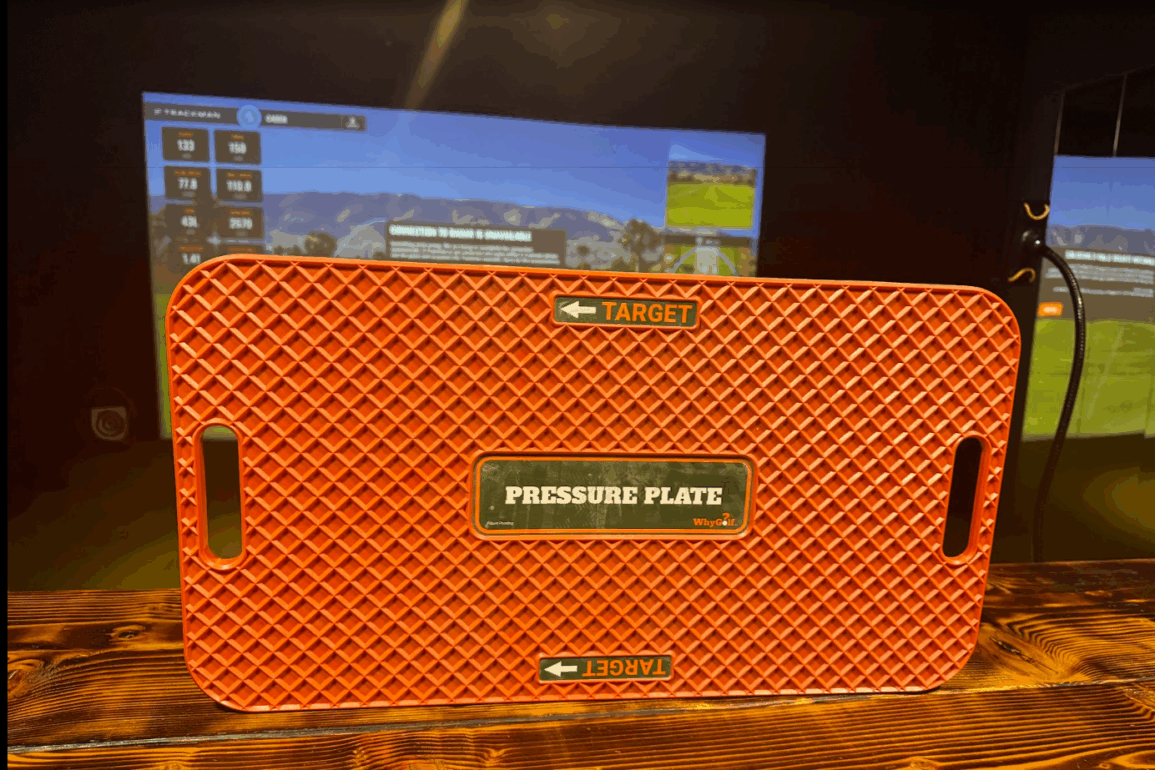The WhyGolf Pressure Plate is a simple, sturdy training aid that gives golfers immediate feedback on weight shift during the swing. Shaped like a see-saw, it rocks forward when pressure is applied to the lead foot — helping golfers learn to post properly into impact. It’s low-tech, portable, and easy to use, especially when paired with launch monitors like TrackMan to evaluate its impact on metrics like launch angle, spin loft, and carry distance. However, at $99, it’s a premium price for a passive tool — read on to see whether it’s worth it for your game.
Efficacy
The Pressure Plate is highly effective at training ground force mechanics through feel. By physically tipping when the user shifts weight forward, it reinforces a proper transition and finish position. This can help reduce early extension, scooping, or reverse pivots. When used regularly, it builds better low-point control and compression.
It excels in training sequencing and awareness but doesn’t address swing plane, face control, or path. Think of it as a targeted feel trainer for pressure — not a comprehensive solution.
Here’s the condensed sequence to follow during a swing:
- Address Setup: Place the Pressure Plate under your left foot (for right-handed golfers), with the arrows pointing toward the target. Stand square, balanced, and athletic.
- Backswing: Keep your weight centered and avoid drifting over your trail foot. Maintain coil and stability.
- Transition: Shift your weight into your lead foot as the downswing begins. The Pressure Plate should audibly and physically tip forward at this exact moment.
- Impact: Your weight should be mostly on your lead foot (around 80%). You should feel braced and posted through impact with hands leading the clubface.
- Finish: Maintain balance with all weight on the front side. The Pressure Plate should stay fully tipped forward.
This sequence helps reinforce the feel of proper ground engagement — critical for low-point control, compression, and repeatable ball-first contact.
Ease of Use
Setup is instant: place it under your lead foot, and you’re ready to go. No batteries, no calibration, and no learning curve. It’s light enough to carry in a golf bag, works indoors and out, and can be used with or without hitting balls.
Its stability is a major plus. Unlike wobbly balance discs or DIY contraptions, the WhyGolf model is solid underfoot. Players can confidently make full swings without slipping, which makes it ideal for sustained use over time.
Measurability
The Pressure Plate doesn’t collect data itself, but it integrates well into a measurable routine when paired with TrackMan or similar systems. Users can monitor key metrics like attack angle, spin loft, ball speed, launch angle, spin rate, height, and carry distance.
Below is a sample TrackMan comparison using a 7-iron before and after Pressure Plate work:
| Metric | Comparison and Interpretation |
|---|---|
| Attack Angle | Improved from -3.6° to -5.1°. Ground pressure through the lead foot steepens the angle, helping ensure ball-first contact and reducing the risk of fat shots. |
| Spin Loft | Dropped from 34.4° to 30.0°. Too much spin loft without weight shift leads to high, floaty shots. Lower spin loft with better pressure results in stronger compression. |
| Ball Speed | Increased from 65.2 mph to 69.4 mph. More efficient ground use helps transfer energy better — even if club speed remains unchanged. |
| Launch Angle | Decreased from 22.1° to 17.9°. A better pressure shift lowers launch, giving a more penetrating ball flight. |
| Spin Rate | Rose from 5500 rpm to 5800 rpm. This slight increase correlates with better face control and strike quality, helping maintain green-stopping control. |
| Height | Reduced from 28 ft to 23 ft. Lower peak height reflects a more compressed, controlled shot — consistent with a better strike and reduced dynamic loft. |
| Carry Distance | Increased from 68.7 yds to 81.5 yds. This is the practical payoff for learning to sequence from the ground up. |
To evaluate your own swing like this, open the TrackMan Shot Optimizer, select your club, and review the bar graphs for each of the metrics above. The blue zones show your target ranges. Comparing before and after training gives you a clear visual confirmation of whether your swing is trending toward more efficient and powerful ball striking.
Cost
At $99, the WhyGolf Pressure Plate is priced near the top of the no-tech golf training aid market. While its durable construction and golf-specific feedback are strong points, the price is difficult to justify for most recreational players — especially when it offers no built-in data, has no adjustability, and relies entirely on feel.
Comparable results can often be achieved using lower-cost tools. A $19 AmazonBasics Wobble Balance Board provides instability that builds lower-body control and awareness. Even more specific to the Pressure Plate’s intent are rocker boards. These also mimic forward-tipping action and can also simulate the sensation of weight transfer into the front side during transition, helping train the same lead-side posting pattern promoted by the WhyGolf model. What separates the Pressure Plate is its refined feel, consistent resistance, and golf-specific footprint. But those refinements come at a high markup. For many players, especially those not practicing with a launch monitor or working under a coach, these extras may not be worth the added cost.
Final Take
Despite offering clear feedback and measurable improvement when combined with structured launch monitor use, the WhyGolf Pressure Plate is ultimately difficult to recommend for most golfers. At $99, it lacks adjustability, built-in data tracking, and broader swing diagnostic utility. For casual players or those on a budget, lower-cost options like balance discs or wobble boards provide much of the same benefit at a fraction of the cost. Unless you’re a coach or dedicated data-driven player, this tool may not deliver enough return on investment.
